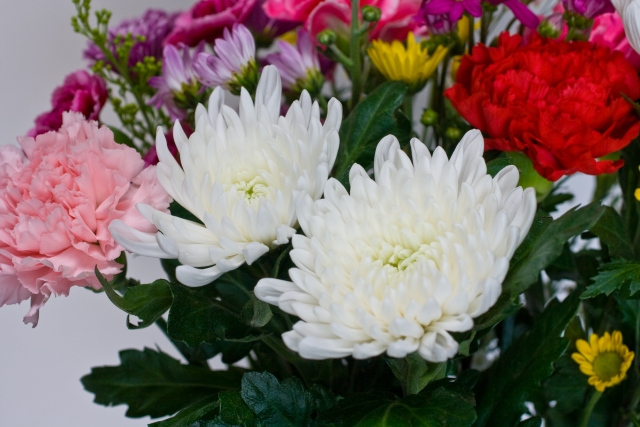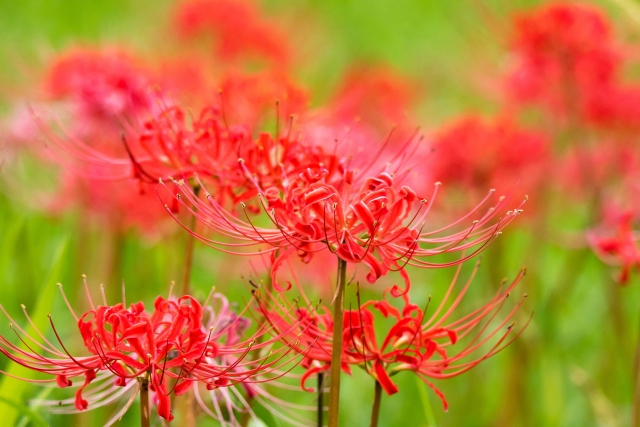皆さんこんにちは、英学です。

お彼岸になると多くの日本人は実家に帰省したり、家族と一緒にお墓参りに行きます。
でもお彼岸という習慣がない外国人から「お彼岸って何?」「何でみんな実家に帰ったり、お墓参りに行くの?」と聞かれます。
そんな時、英語で説明できますか?
習慣や慣習といった当たり前にやっていることは意外と日本語でも説明出来なかったりしますよね。
日本独特の習慣である「お彼岸」を英語で説明しようとすると難しいものです。
そこで今回はお彼岸にまつわる説明を20選の英語フレーズにまとめて紹介します!
これさえ覚えておけばお彼岸について聞かれてもまず困ることはなくなるでしょう。
自信をもって外国人に説明してみてくださいね。
「お彼岸」は海外にはない日本固有の習慣なので英語でもそのまま「Higan」と表現します。
【目次】
1, お彼岸とは
1, Higan is a traditional seven-day Buddhist ceremony to honor the ancestors, during the spring and fall equinoxes.
お彼岸は春分と秋分の1週間の間に先祖供養をする伝統的な仏事です。
2, Higan centers on the Shyunbun-no-hi or spring equinox and Shubun-no-hi or fall equinox.
3, Higan is a Buddhist word which means “the other shore” and a metaphor for the world after death.
お彼岸は仏教用語で「向こう岸」を意味し、死後の世界を意味しています。
4, In Buddhism, Higan means the enlightened world and is believed to be in the far west while the other side in the east is the world we live, Shigan.
仏教ではお彼岸は悟りの世界を意味し西の彼方にあり、我々が生きている世界である此岸は東にあるとされています。
5, Since the spirits of ancestors are believed to come back to this world during Higan period, we have an unique custom to visit our ancestors’ graves during this time.
お彼岸には先祖の霊が帰ってくると信じられているので、この期間に先祖のお墓参りに行くという独特の習慣があります。
6, During Higan period, we visit our family graves and clean them, then offer flowers, incense and special sweets made of rice and red bean paste for them.
お彼岸には先祖のお墓に行き掃除をして、花や線香、おはぎなどのお供えをします。

7, People visit their parents’ or grandparents’ house near family graves during Higan.
お彼岸の間に、家族のお墓の近くにある実家や祖父母の家を訪れます。
8, This traditional custom is still continued in Japan because we believe that we will be rewarded with happiness in the afterlife by praying for our ancestors.
先祖の供養をすることで極楽浄土へ行くことができると信じられているので、日本では現在でもこの伝統的な習慣が続いています。
9, Spring and fall equinox days are the days when day and night are almost equally long.
10, People thought the sprits of ancestors can cross the river which divides this world and the spirit world on the equinox days because on the days of the equinox, the sun rises from the exact east and sets in the exact west.
あの世にいる先祖の霊は春分の日と秋分の日は太陽が真東からのぼり、真西に沈むことからこの世との境にある川を渡って来れると考えられていました。
2, お彼岸と気候
11, There is a Japanese saying that ”Summer heat or winter cold doesn’t last after the equinox.”which recognizes the equinoxes as boundaries between seasons.
日本には「暑さ寒さも彼岸まで」ということわざがあり、お彼岸が季節の変わり目とされています。
12, After Higan in spring or haru-higan, the days become longer and it gets warmer toward summer and following Higan in fall or aki-higan, the days become shorter and we gradually anticipate the arrival of winter.
春彼岸を過ぎると昼が長くなって夏に向かって暖かくなり、秋彼岸を過ぎると日が短くなり、徐々に冬の気配を感じるようになります。

3, おはぎ
13, People offer Ohagi, a Japanese bean cake, to the Buddha on fall equinox day.
秋分の日にはおはぎを仏様に供えます。
14, Ohagi is a sticky rice ball covered with sweet red bean paste.
おはぎはもち米を丸め、あんこで包んだものです。

15, This sweet red bean paste is made from Azuki beans.
このあんこは小豆から作られています。
16, Ohagi coated with roasted soybean flour or sesame on sweet red bean paste are also popular.
きな粉やごまをあんこの上にまぶしたおはぎも人気があります。

17, People eat Ohagi during Higan because Azuki beans which is material of the red bean paste was believed to have power to keep off evil.
お彼岸におはぎを食べるのはあんこの原料である小豆が悪魔を払う力があると信じられていたからです。
18, We call it Ohagi in the fall, but we also call it botamochi in the spring.
秋には「おはぎ」、春には「牡丹餅」と呼びます。
19, Ohagi is named after “hagi”, the Japanese bush clover.
おはぎは、萩にちなんで名付けられました。
20, Botamochi is named after “botan”, the tree peony.
牡丹餅は、牡丹にちなんで名付けられました。
この記事に書かれているフレーズは以下の動画にも収録されていますので、是非一度視聴して声に出して何度も繰り返し練習して自分のものにして下さいね。
いかがですか?
お彼岸について説明するときに使えるフレーズ20選を紹介しました。
少し長めのフレーズも含まれていましたが、ある程度しっかりした内容を盛り込むとこの程度の説明は最低限必要かと思います。
お彼岸については日本固有の風習なので、海外の人にとってはなかなか理解しづらいものかもしれません。
少しでも「こういう感じのものなんだな」と理解してもらえるように、今回取り上げたフレーズなどを使って基本的なことを説明できるようにしておきましょうね!
最後まで読んで頂きありがとうございました。
今回の内容に関連するブログ記事と動画をご紹介しておきます。↓
【お寺で使える英語フレーズ20選】「What's "Tera"?」
【お盆を英語で説明!使える英語フレーズ20選】「What's "Obon"?」
是非、ご覧下さい。